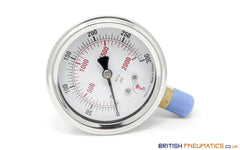Stainless Steel Pneumatic Components

Pneumatic components are available in a variety of materials and finishes. Brass, Low Carbon Steel and certain types of plastic are all commonly used for fittings, cylinders, valves and filter components.
Despite its higher cost, there are some excellent reasons to use Stainless Steel Pneumatic components, we’ll discuss these in this article.
What is Stainless Steel?
One of the most commonly seen materials in any food and beverage manufacturing plant is Stainless Steel. Stainless Steel is an alloy consisting mainly of Iron and Chromium, with the latter differentiating it from regular Mild or Low Carbon Steel. Other elements such as Manganese, Phosphorus and Silicon are used to improve other properties, depending on the particular grade.
The Chromium content creates a layer of Chromium Oxide on the surface, protecting the part from corrosion without the need for any other surface treatments. This surface is effectively self healing, meaning any scratches will not corrode.
Common Types
The different variations of stainless steel are termed grades. There are 5 main groups, with sub-grades to each, these are from ‘200 series’ through to ‘600 series’. There are some outliers called ‘Duplex’ grades that are used for very specific applications.
The most commonly used, in the food industry, are 304 and 316. This is primarily due to the wide range of useful material properties they exhibit. 304 is generally the lower cost grade. Nickel is added in greater quantities to create 316. This gives improved corrosion resistance, especially in extreme environments such as marine applications. 304 and 316 Stainless Steel - Thussenkrupp 2020.
Composition of Stainless Steel

Why is it Used so Widely?
Walk into any food and beverage business anywhere in the world, and you’ll see Stainless Steel is everywhere, from worktops, benches and tanks to Stainless Steel Pneumatic Components built into production lines.
Corrosion Resistance
In food and other hygienic industries, cleanliness is paramount. Stainless Steel allows components to remain rust free without the use of paints or other surface coverings.
Not only an extra cost, painting can often be unsanitary, as it requires maintenance, can become difficult to clean and in extreme cases be a source of contaminants.

Source: Unsplash
Chemical Resistance
Pneumatic components are used in a wide variety of applications, using 316 grade Stainless Steel Pneumatic Components gives an even wider scope, as these are resistant to many chemicals used in cleaning and processing, particularly in the Bottling industry in the UK and beyond.
This also means Stainless Steel components can be kept clean without the risk of damaging or marring the surface finish or surface coatings.
Hardness and Strength
Whilst other materials such as Aluminium and Brass are also corrosion resistant, they do not possess the same strength characteristics as Stainless Steel. With tensile strength values often higher than Mild Steel by around 10% (1), and hardness properties often exceeding it, Stainless offers great mechanical and wear resistance. Bssa.or.uk - 2021
This allows use in high load and high wear applications. This is a particularly useful property for products such as pneumatic grippers. Commonly used in the UK F&B industry, a high tensile strength allows the components to be compact and provide a high force gripping solution. These are often used in bottling production lines.
Temperature Resistance
A common use of certain types of stainless steel is in Cryogenic applications. 304 and 316 grades retain their tensile strength down to well below -100°C. Temperatures such as this will cause standard mild steels to exhibit brittle failures at a fraction of their ultimate strength.
This is an especially useful characteristic as many processes in medical, bottling and pharmaceutical industries involve extremes of cold, in part due to the use of chemicals such as Liquid Nitrogen and compressed gases.
When Carbon Dioxide is used in the production of bottled beverages, the expansion of the gas from a containment tank to the various process systems, causes an extreme cold condition. Particularly important with valves and safety systems, Stainless Steel enables these components to continue working as required, even in near-cryogenic conditions.

Longevity
The hardness and strength of Stainless Steel also lends itself to longevity. Pneumatic Components having a longer service life reduces costs through multiple ways, including longer maintenance schedules, and less replacement costs.
Another benefit achieved by using a naturally corrosion resistant material, that is one that does not need or have a coating; is the low wear resistance of this coating. With Nickel or Zinc plated components, especially quick release fittings, the plating will wear with normal use. Making use of Stainless Steel Pneumatic Components will reduce the wear impact.
Manufacturing Ease
Pneumatic Components often contain precise, complex geometry, one example is our Watson Pressure Gauges. The cost of manufacture is a large influencing factor on the cost of the final product.
Thankfully, Stainless Steel can be readily machined, drilled, polished and welded. This allows them to be easily used for almost any component, whilst still maintaining their affordability.
Safety in High Pressure Pipework and Components
Compressed gases can be extremely dangerous if handled incorrectly. Compressor systems require regular inspection, and specifically air tanks. One of the reasons for this is the tendency for moisture to gather inside pipework, this can then cause increased corrosion rates internally, which can be hidden from view.
The corrosion resistance of Stainless Steel gives the peace of mind that no water ingress or moisture build up will cause damage. Especially important in high pressure systems or systems in close proximity to people.

